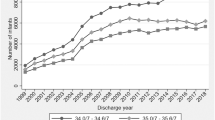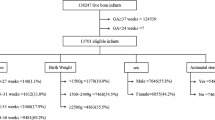Abstract
Objective
To examine outcomes at two institutions with different approaches to care among infants born at 22 weeks of gestation.
Study design
Retrospective, cohort study (2006–2015). Enrollment was limited to mother–infant dyads at 22 weeks of gestation. Proactive care was defined as provision of antenatal corticosteroids and neonatal resuscitation and intensive care. One center (Uppsala, Sweden; UUCH) provided proactive care to all mother–infant dyads (comprehensive center); the other center (Nationwide Children’s Hospital, USA; NCH) initiated or withheld treatment based on physician and family preferences (selective center). Differences in outcomes between the two centers were evaluated.
Result
Among 112 live-born infants at 22 weeks of gestation, those treated at UUCH had in-hospital survival rates higher than those at NCH (21/40, 53% vs. 6/72, 8%; P < 0.01). Among the subgroup of infants receiving proactive care (UUCH: 40/40, 100%; NCH: 16/72, 22%) survival was higher at UUCH than at NCH (21/40, 53% vs. 3/16, 19%; P < 0.05).
Conclusion
Even when mother–infant dyads were provided proactive care at NCH (selective center), survival was lower than infants provided proactive care at UUCH (comprehensive center). Differences between the approaches to care at the two centers at 22 weeks of gestation merits further investigation.
This is a preview of subscription content, access via your institution
Access options
Subscribe to this journal
Receive 12 print issues and online access
$259.00 per year
only $21.58 per issue
Buy this article
- Purchase on Springer Link
- Instant access to full article PDF
Prices may be subject to local taxes which are calculated during checkout


Similar content being viewed by others
References
Lantos JD, Meadow W. Variation in the treatment of infants born at the borderline of viability. Pediatrics. 2009;123:1588–90.
Raju TN, Mercer BM, Burchfield DJ, Joseph GF Jr. Periviable birth: executive summary of a joint workshop by the Eunice Kennedy Shriver National Institute of Child Health and Human Development, Society for Maternal-Fetal Medicine, American Academy of Pediatrics, and American College of Obstetricians and Gynecologists. Obstet Gynecol. 2014;123:1083–96.
Singh J, Fanaroff J, Andrews B, Caldarelli L, Lagatta J, Plesha-Troyke S, et al. Resuscitation in the “gray zone” of viability: determining physician preferences and predicting infant outcomes. Pediatrics. 2007;120:519–26.
Ancel PY, Goffinet F, Kuhn P, Langer B, Matis J, Hernandorena X, et al. Survival and morbidity of preterm children born at 22 through 34 weeks’ gestation in France in 2011: results of the EPIPAGE-2 cohort study. JAMA Pediatr. 2015;169:230–8.
Costeloe K, Hennessy E, Gibson AT, Marlow N, Wilkinson AR. The EPICure study: outcomes to discharge from hospital for infants born at the threshold of viability. Pediatrics. 2000;106:659–71.
Holtrop P, Swails T, Riggs T, De Witte D, Klarr J, Pryce C. Resuscitation of infants born at 22 weeks gestation: a 20-year retrospective. J Perinatol. 2013;33:222–5.
Larroque B, Breart G, Kaminski M, Dehan M, Andre M, Burguet A, et al. Survival of very preterm infants: Epipage, a population based cohort study. Arch Dis Child Fetal Neonatal Ed. 2004;89:F139–144.
Stoll BJ, Hansen NI, Bell EF, Walsh MC, Carlo WA, Shankaran S, et al. Trends in care practices, morbidity, and mortality of extremely preterm neonates, 1993-2012. JAMA. 2015;314:1039–51.
Vanhaesebrouck P, Allegaert K, Bottu J, Debauche C, Devlieger H, Docx M, et al. The EPIBEL study: outcomes to discharge from hospital for extremely preterm infants in Belgium. Pediatrics. 2004;114:663–75.
Gallagher K, Aladangady N, Marlow N. The attitudes of neonatologists towards extremely preterm infants: a Q methodological study. Arch Dis Child Fetal Neonatal Ed. 2016;101:F31–36.
Backes CH, Rivera BK, Haque U, Srouji L, Beck S, Yin H, et al. A proactive approach to neonates born at 23 weeks of gestation. Obstet Gynecol. 2015;126:939–46.
Lantos JD. We Know Less Than We Think We Know About Perinatal Outcomes. Pediatrics 2018;142:e20181223.
Tyson JE, Parikh NA, Langer J, Green C, Higgins RD. Intensive care for extreme prematurity--moving beyond gestational age. N Engl J Med. 2008;358:1672–81.
Rysavy MA, Li L, Bell EF, Das A, Hintz SR, Stoll BJ, et al. Between-hospital variation in treatment and outcomes in extremely preterm infants. N Engl J Med. 2015;372:1801–11.
Patel RM, Rysavy MA, Bell EF, Tyson JE. Survival of infants born at periviable gestational ages. Clin Perinatol. 2017;44:287–303.
Nankervis CA, Martin EM, Crane ML, Samson KS, Welty SE, Nelin LD. Implementation of a multidisciplinary guideline-driven approach to the care of the extremely premature infant improved hospital outcomes. Acta Paediatr. 2010;99:188–93.
Hakansson S, Farooqi A, Holmgren PA, Serenius F, Hogberg U. Proactive management promotes outcome in extremely preterm infants: a population-based comparison of two perinatal management strategies. Pediatrics. 2004;114:58–64.
American College of Obstetricians and Gynecologists and the Society for Maternal–Fetal Medicine, Ecker JL, Kaimal A, Mercer BM, et al. Periviable birth: interim update. Am J Obstet Gynecol. 2016;215:B2–B12.e11.
Rysavy MA, Marlow N, Doyle LW, Tyson JE, Serenius F, Iams JD, et al. Reporting outcomes of extremely preterm births. Pediatrics. 2016;138:3.
Perlman JM, Wyllie J, Kattwinkel J, Atkins DL, Chameides L, Goldsmith JP, et al. Part 11: Neonatal resuscitation: 2010 International Consensus on Cardiopulmonary Resuscitation and Emergency Cardiovascular Care Science With Treatment Recommendations. Circulation. 2010;122 16 Suppl 2:S516–538.
Wu YW, Escobar GJ, Grether JK, Croen LA, Greene JD, Newman TB. Chorioamnionitis and cerebral palsy in term and near-term infants. JAMA. 2003;290:2677–84.
Fenton TR, Kim JH. A systematic review and meta-analysis to revise the Fenton growth chart for preterm infants. BMC Pediatr. 2013;13:59.
Jobe AH, Bancalari E. Bronchopulmonary dysplasia. Am J Respir Crit Care Med. 2001;163:1723–9.
Gargus RA, Vohr BR, Tyson JE, High P, Higgins RD, Wrage LA, et al. Unimpaired outcomes for extremely low birth weight infants at 18 to 22 months. Pediatrics. 2009;124:112–21.
Younge N, Goldstein RF, Bann CM, Hintz SR, Patel RM, Smith PB, et al. Survival and neurodevelopmental outcomes among periviable infants. N Eng J Med. 2017;376:617–28.
Mehler K, Oberthuer A, Keller T, Becker I, Valter M, Roth B, et al. Survival among infants born at 22 or 23 weeks’ gestation following active prenatal and postnatal care. JAMA Pediatr. 2016;170:671–7.
Guillen U, Weiss EM, Munson D, Maton P, Jefferies A, Norman M, et al. Guidelines for the management of extremely premature deliveries: a systematic review. Pediatrics. 2015;136:343–50.
Janvier A, Baardsnes J, Hebert M, Newell S, Marlow N. Variation of practice and poor outcomes for extremely low gestation births: ordained before birth? Arch Dis Child Fetal Neonatal Ed. 2017;102:F470–F471.
Yeo KT, Lee QY, Quek WS, Wang YA, Bolisetty S, Lui K. Trends in morbidity and mortality of extremely preterm multiple gestation newborns. Pediatrics. 2015;136:263–71.
Garg P, Abdel-Latif ME, Bolisetty S, Bajuk B, Vincent T, Lui K. Perinatal characteristics and outcome of preterm singleton, twin and triplet infants in NSW and the ACT, Australia (1994-2005). Arch Dis Child Fetal Neonatal Ed. 2010;95:F20–24.
Delbaere I, Goetgeluk S, Derom C, De Bacquer D, De Sutter P, Temmerman M. Umbilical cord anomalies are more frequent in twins after assisted reproduction. Hum Reprod. 2007;22:2763–7.
Reddy UM, Rice MM, Grobman WA, Bailit JL, Wapner RJ, Varner MW, et al. Serious maternal complications after early preterm delivery (24-33 weeks’ gestation). Am J Obstet Gynecol. 2015;213:538 e531–539.
American College of Obstetrics and Gynecology. ACOG practice bulletin. Perinatal care at the threshold of viability. Number 38, September 2002. American College of Obstetrics and Gynecology. Int J Gynaecol Obstet.2002;79:181–8..
Anderson PJ, De Luca CR, Hutchinson E, Roberts G, Doyle LW,Victorian Infant Collaborative Group. Underestimation of developmental delay by the new Bayley-III Scale. Arch Pediatr Adolesc Med. 2010;164:352–6.
Perla RJ, Provost LP, Murray SK. The run chart: a simple analytical tool for learning from variation in healthcare processes. BMJ Qual Saf. 2011;20:46–51.
Acknowledgements
The authors would like to acknowledge Drs. Charles V Smith (Seattle Children’s Research Institute, University of Washington School of Medicine, Seattle, WA, USA) and Edward Bell (Department of Pediatrics, University of Iowa, Iowa City, IA, USA) for their contributions to the manuscript.
Author contributions
CHB, FS, JA, and BKR were involved in the acquisition of data and analysis and interpretation of data conception and design of manuscript, drafting the article, and revising it critically for important intellectual content; final approval of the version to be published, and provided agreement to be accountable for all aspects of the work in ensuring that questions related to the accuracy or integrity of any part of the work are appropriately investigated and resolved. RS and CWB were involved in the interpretation of data analysis, drafting the article, and revising it critically for important intellectual content; final approval of the version to be published, and provided agreement to be accountable for all aspects of the work in ensuring that questions related to the accuracy or integrity of any part of the work are appropriately investigated and resolved. CCM, HAF, and EGS were involved in the analysis and interpretation of data; drafting the article and revising it critically for important intellectual content; final approval of the version to be published, and provided agreement to be accountable for all aspects of the work in ensuring that questions related to the accuracy or integrity of any part of the work are appropriately investigated and resolved. LDN and EN were involved in substantial contributions to conceptualization and design of the study; drafting the article and revising it critically for important intellectual content; final approval of the version to be published, and provided agreement to be accountable for all aspects of the work in ensuring that questions related to the accuracy or integrity of any part of the work are appropriately investigated and resolved.
Author information
Authors and Affiliations
Corresponding author
Ethics declarations
Conflict of interest
The authors declare that they have no conflict of interest.
Rights and permissions
About this article
Cite this article
Backes, C.H., Söderström, F., Ågren, J. et al. Outcomes following a comprehensive versus a selective approach for infants born at 22 weeks of gestation. J Perinatol 39, 39–47 (2019). https://doi.org/10.1038/s41372-018-0248-y
Received:
Revised:
Accepted:
Published:
Issue Date:
DOI: https://doi.org/10.1038/s41372-018-0248-y
This article is cited by
-
Development of a small baby unit to improve outcomes for the extremely premature infant
Journal of Perinatology (2022)
-
Established severe BPD: is there a way out? Change of ventilatory paradigms
Pediatric Research (2021)
-
Challenging the gestational age for the limit of viability: proactive care
Journal of Perinatology (2019)
-
Reduced rate of treated retinopathy of prematurity after implementing lower oxygen saturation targets
Journal of Perinatology (2019)



